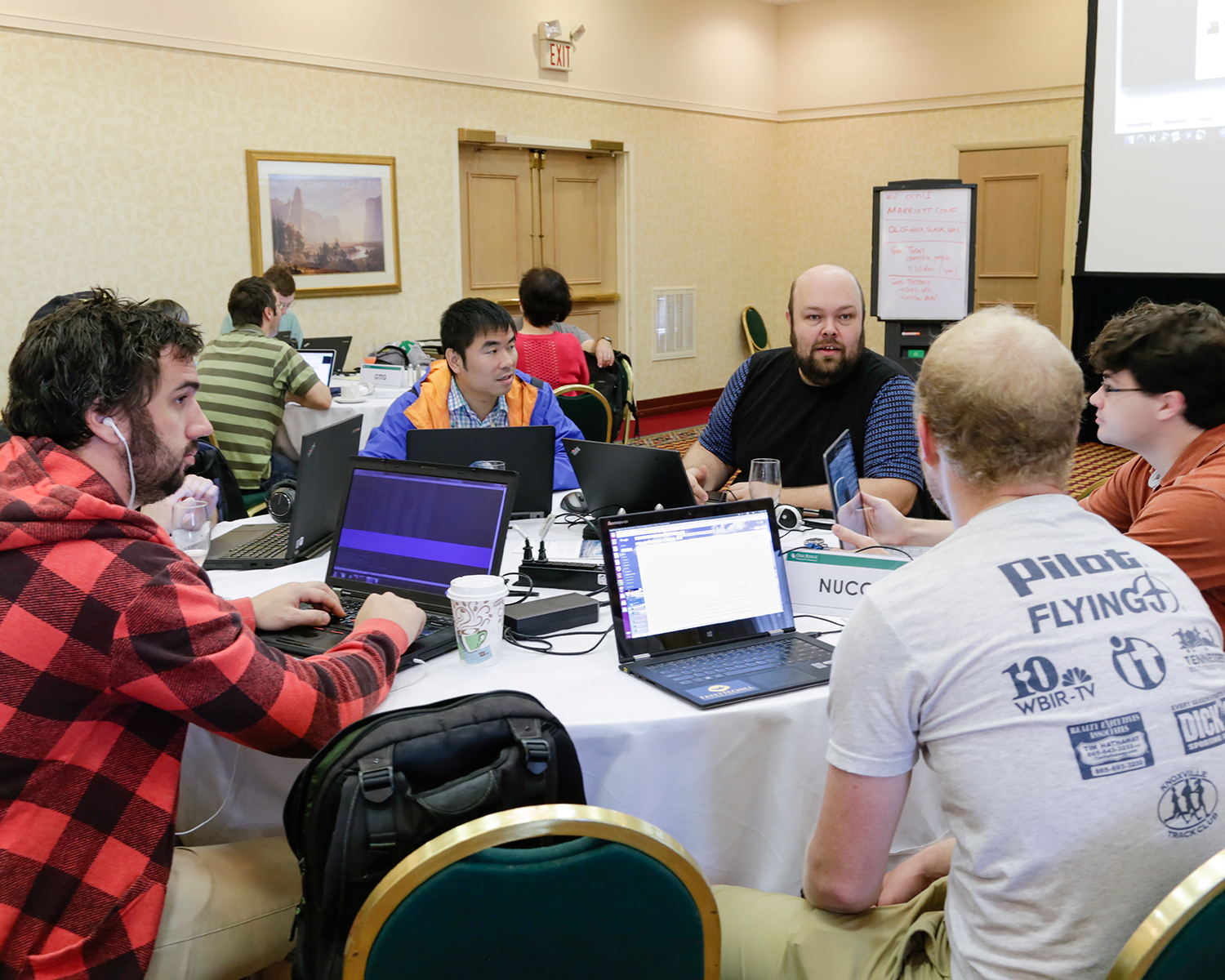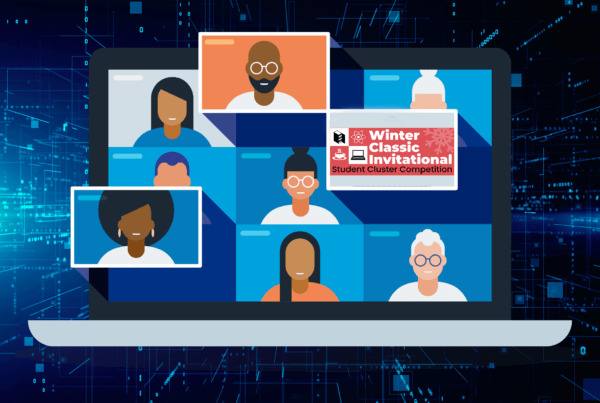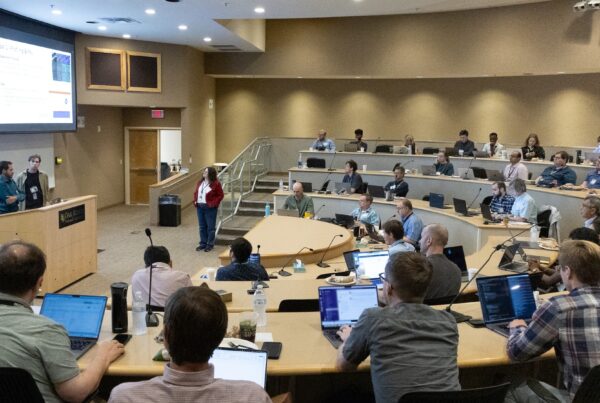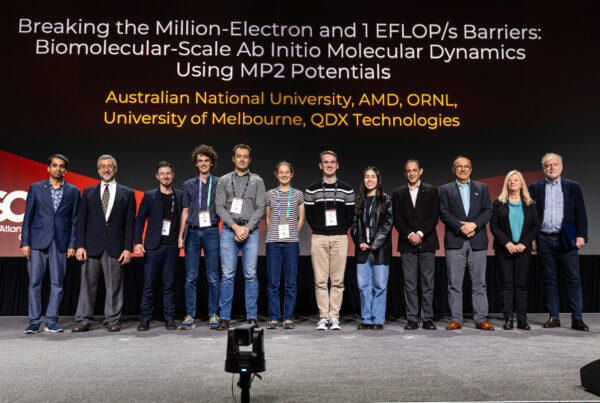
OLCF Scientific Computing Liaison Gustav Jansen, center, works with members of the NUCCOR team during the October 2016 GPU Hackathon.
A hackathon week unfolds organically and evolves with a distinct rhythm.
Fernanda Foertter, user assistance specialist and hackathon coordinator for the Oak Ridge Leadership Computing Facility (OLCF), a US Department of Energy (DOE) Office of Science User Facility located at DOE’s Oak Ridge National Laboratory (ORNL), has seen three of them play out that way this year. The latest hackathon, which took place the week of October 17, was the eighth such event, and its format was generally the same as that of its predecessors. Still, each has had its own unique qualities.
“There are growth pains throughout the week,” Foertter said, “but by the end of the week, participants have seen progress, experienced a breakthrough. And the teams tell me, ‘This coding would have taken me months. We did it in a week. It’s amazing.’”
Another interesting dynamic she notes is how teams from disparate fields come together. The unifying factor is porting code on the GPU. Because they combine efforts to reach that goal, the teams share in and celebrate each other’s successes.
Hackathons provide an opportunity for programmers from organizations to interact with high-performance computing (HPC) experts, and the resulting brainstorming can net wonderful results. “Often companies don’t have a lot of access to experts, or they would have to hire consultants. An event like this is helpful for them to give them a push to the next level,” explained Foertter.
For instance, the St. Jude team that participated in the most recent event found out about the hackathons through a LinkedIn connection. The team was composed of a physicist, a scientific programmer, and an HPC specialist, all from St. Jude’s, and a fourth member based at the University of Texas Health Science Center.
“They’re working on a couple codes,” Foertter said. “They don’t have a lot of GPU experience, so this is one way we can help the research going on at a place like St. Jude’s. They wouldn’t necessarily fit into any of the other OLCF programs, so it’s a unique opportunity for them to sit with an expert for a week and ask ‘How do you do this?’ or ‘How do you achieve that?’” she said.
Another team was from Duke University. According to its website, Duke’s philosophy is “access and flexibility.” In a way, that’s a perfect description of the hackathon.
The Duke-based team is a materials science group working on density functional theory, a method of modeling quantum mechanical systems. It can determine a many-body system’s electronic structure and is thus useful in computational physics, chemistry, and materials science.
An ORNL-based team led by David Page found the networking with OLCF vendor partners to be extremely helpful and the event a way to learn about scaling to Titan, the OLCF’s flagship supercomputer.
“The event was a huge success for our team. We started the event with an app that only ran on a single threaded CPU, and we ended the week with the app running on GPUs and CPUs via three different variations of acceleration—OpenMP, OpenACC, and CUDA,” Page said. “Not only did our team walk away as a much better team, but we also now have an understanding of how to scale our apps for Titan, and perhaps more importantly, we know who—PGI, NVIDIA, Cray, OLCF—and what resources, such as VAMPIR and SCOREP, are available as we move forward.” Those vendor partners provided mentoring to the participants throughout the week.
Another team from Georgia Tech, led by P. K. Yeung, found the October hackathon to be a wonderful learning opportunity for students and a way to gain insight about the coming of Summit, OLCF’s next system scheduled to begin operation in 2018.
“I was so impressed, and grateful, for the advice and help that our two mentors kindly provided.
I am hoping to be able to use OpenACC, including even the future Summit machine at Oak Ridge, to reach at least pre-exascale levels of code performance and make the science discoveries that will become possible at that scale,” Yeung said.
Foertter noted the goal is for the teams to make progress here and then use what they’ve learned during the week so they can go home and continue the work. “It was a pleasure hosting these teams, and I look forward to learning about their future scientific outcomes,” she stated.
The nine hackathon teams participating in this event were GPU Gyros, GTTG, HACME2, The Hybrid Titans, NUCCOR, Pixel Herders, Risky Competitors, SELFies, and Team FHI Aims.
Oak Ridge National Laboratory is supported by the US Department of Energy’s Office of Science. The single largest supporter of basic research in the physical sciences in the United States, the Office of Science is working to address some of the most pressing challenges of our time. For more information, please visit science.energy.gov.






